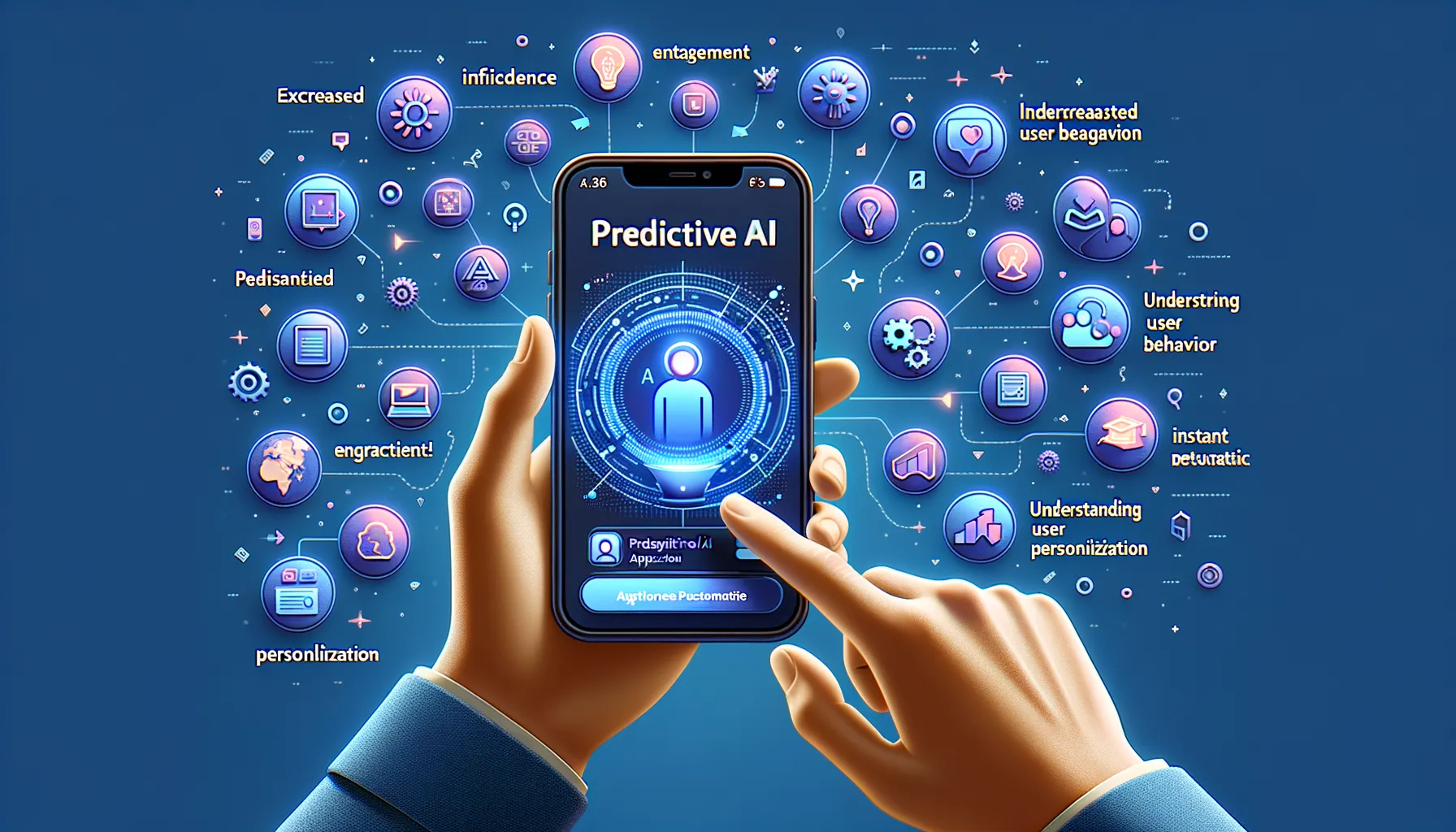Understanding Predictive AI and Its Role in Mobile Apps
How Predictive AI Transforms Mobile App Interactions
Imagine opening a mobile app that seems to know exactly what you need before you even tap a button. This isn’t magic—it’s the power of Predictive AI. By analyzing your habits, preferences, and behaviors, Predictive AI breathes intelligence into apps, turning them into almost empathetic digital companions.
At its core, predictive algorithms sift through massive amounts of user data to forecast the next step. For instance, a fitness app might suggest a workout based on your previous sessions, weather conditions, or even your mood (yes, that’s possible). It doesn’t just react; it anticipates, creating seamless, almost intuitive experiences.
- A streaming app suggests your next binge-worthy series before you’ve finished the last episode.
- A shopping platform highlights products you never knew you wanted, but can’t resist buying.
- Even language learning apps tweak lesson plans based on how well you’re retaining information.
An Invisible Brain Working Behind the Scenes
What fuels this brilliance? A mix of machine learning models, user behavior analysis, and real-time updates. It’s not just looking at where you clicked today; it remembers your choices from weeks ago. For example, Predictive AI in ride-hailing apps can guess your destination during specific times—like work at 8 AM or home after 6 PM—not just based on location, but your daily rhythm.
This isn’t just tech; it’s a revolution in how we engage digitally. And let’s be honest, the best apps now feel less like tools and more like personal assistants who’ve finally learned your quirks.
Key Strategies for Enhancing User Experience Using AI

Personalized Recommendations That Wow
Imagine opening a mobile app and feeling as if it just “gets” you. That’s the magic of leveraging AI-driven personalization. Predictive algorithms analyze user data—like browsing habits or past purchases—and craft tailored suggestions that feel less like sales pitches and more like thoughtful advice from a close friend.
Think of a streaming app predicting exactly what movie you’re in the mood for after a long day. Or, an e-commerce app suggesting the perfect outfit for that wedding you mentioned weeks ago. AI makes these experiences not only possible but seamless, giving users a sense of connection and care.
- Analyze user behavior to predict preferences.
- Adjust layouts dynamically based on their actions (e.g., swipe patterns).
- Offer personalized push notifications without being intrusive.
Simplify Navigation with Predictive Intelligence
No one loves a maze—not in real life and especially not in an app. With predictive navigation, AI can anticipate where users are trying to go, eliminating unnecessary steps. Think autocomplete that suggests your destination before your fingers finish typing or smart menus that pre-load frequently accessed features.
Concrete example? Picture a finance app predicting you’ll want to check your balances first thing Monday morning, so it loads that screen instantly upon opening. It’s not just speed; it’s intuition. This predictive design not only saves time but creates a level of ease that keeps users coming back.
Benefits of Predictive AI for Mobile Application Users

Why Predictive AI Feels Like Magic for App Users
Imagine opening your favorite shopping app, and it knows exactly which product you were *just about to search for*. Or think of your fitness tracker nudging you to move at the perfect moment, knowing when you’re most likely to respond. Sounds like telepathy? Nope, it’s the invisible hand of predictive AI. For mobile app users, this technology doesn’t just make apps smarter—it makes them feel tailored just for *you*.
Here are a few ways predictive AI upgrades the user experience:
- Hyper-personalized recommendations: From suggesting movies on a streaming app to curating playlists, it adapts to your unique habits.
- Time-saving automation: Think autofill magic—your preferences, past orders, or even location-based suggestions all served up instantly.
- Proactive problem-solving: Imagine a travel app that notifies you about delays before you scramble to check your flight status.
Predictive AI doesn’t just respond—it anticipates. It’s like having an app that reads between the lines, helping you get what you need before you even realize you need it. Personal, seamless, effortless—that’s the difference users *feel.*
Turning Everyday Apps into Life Assistants
Beyond convenience, predictive AI is transforming apps into trusted companions. A fitness app, for example, can predict your energy dips and suggest stretching routines (goodbye, 3 PM slump!). Or a language-learning app might time reminders when you’re most mentally alert for new lessons. These nudges are subtle but *powerful*.
When technology feels intuitive, users build trust. They stick around longer. That’s the secret sauce predictive AI brings—it bridges the gap between digital tools and human lives, one smart prediction at a time. Every swipe, tap, and notification starts to feel… well, almost thoughtful. And that’s because it *is*.
Challenges and Solutions in Implementing Predictive AI

Pitfalls in Implementation That Might Catch You Off Guard
Predictive AI is like a double-edged sword for mobile apps. It can transform your user experience into a streamlined masterpiece, but getting there? It’s no walk in the park. One common challenge is managing the mountains of data needed to make AI work its magic. Picture this: you’re building an app to recommend playlists based on mood. Sounds cool, right? But first, you’ll need massive datasets—like millions of song preferences—to train your algorithm. Without it, your app’s “predictive” powers might feel more like a wild guess.
Then there’s the tricky issue of balancing personalization with privacy. Users want you to understand them, but not in a creepy, “how-did-you-know-I-needed-socks?” sort of way. Striking that balance often means navigating the complicated waters of data compliance regulations. Mess up here, and you risk losing user trust—or worse, facing legal headaches.
- Lack of clean, structured data: Imagine feeding your AI messy inputs—it’s like training a chef using spoiled ingredients. Yikes.
- Integration hiccups: Your shiny new AI tool may clash with your app’s current tech stack, turning “plug-and-play” into “plug-and-pray.”
Solutions That Save the Day
So, how do you sidestep these landmines? Start by investing in high-quality, robust datasets. Partner with trusted third-party providers if gathering your own data feels overwhelming. And, here’s a pro tip: always perform rigorous testing to ensure your model predicts accurately—even under unusual or edge-case conditions.
For privacy concerns, embrace transparency. Clearly communicate what data you’re collecting and why. Using techniques like federated learning can also be a game-changer; it keeps user data on their devices while still enabling the algorithm to improve. And if compatibility issues arise with older app architecture? Consider modular AI tools that integrate seamlessly rather than forcing everything into a one-size-fits-all system.
At the end of the day, overcoming these hurdles requires a mix of creativity, strategy, and perseverance—but trust us, the rewards are absolutely worth it!
Future Trends in Predictive AI and Mobile App Design

The Fusion of Predictive AI and Human-Centered Design
Imagine your mobile app knowing what you need before you even open it. Sounds like magic? It’s not—it’s the next big thing for predictive AI. The future lies in blending AI’s razor-sharp data-crunching power with designs that feel deeply human. Think of apps that adapt dynamically, like suggesting tailored workout plans based on your morning mood or meal suggestions inspired by your grocery list.
Why stop at predictions when these systems can evolve alongside us? With machine learning becoming more sophisticated, apps will learn from user behavior over time without feeling creepy or intrusive. Picture a travel app that, after a few trips, uncovers your love for boutique hotels and sunrise hikes, creating itineraries that practically read your mind.
- Real-time personalization: Apps dynamically adapting to changing user preferences as they interact.
- Hyper-contextual insights: Features informed by location, weather, or even your calendar.
Immersive Experiences Through Seamless Prediction
Augmented reality (AR) and predictive AI are set to join forces, adding a dash of awe to everyday apps. Imagine a furniture app that not only shows how a chair looks in your living room but predicts which dimensions or colors would best match your home decor based on past searches.
And it’s not just AR—voice assistants are becoming clairvoyant, so to speak. Future voice tech will likely predict commands mid-conversation, making interactions feel intuitive and second nature. As humans, we crave convenience that feels personalized. That’s where predictive algorithms will shine brightest, shaping digital spaces that seem designed specifically for you.
